In this article, we will discuss:
- The Heart of the Issue: A Widespread Lack of Access to Tools for Post-Trading Analysis
- A Closer Look at the Andekha Sach Required to Upgrade Options Trading
- The Importance of Post-Trade Analysis for Improved Options Trading Profitability
- Redefine Your Options Trading Success with the Samco Trading App
- Become a More Successful Options Trader with Samco’s New-Gen Trading App
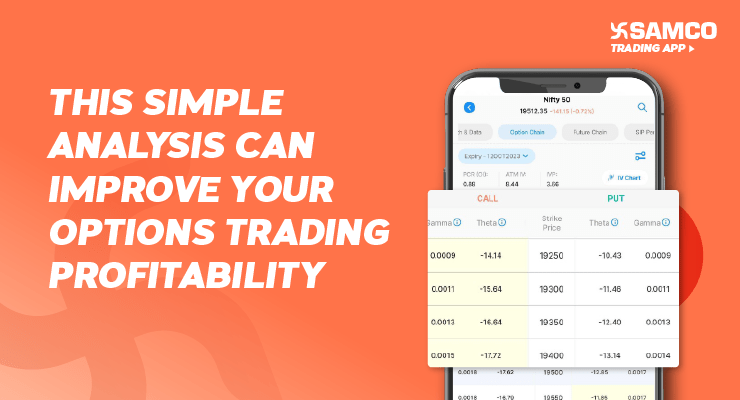
When you rewind and take a look back at the Indian financial markets a decade ago, a few things stand out. The market was dominated by institutional investors, retail investor participation was limited, and individuals were primarily interested in equity investments. Now, less than a few years later, the landscape is vastly different. Here are some interesting developments that have rapidly transformed the investor mix in the markets.
- Retail investor participation in the Indian stock markets has shot up tremendously, with the number of demat accounts rising to 13.23 crores by October 2023 from a mere 3.93 crores in December 2019.
- Futures and options trading, in particular, has become a preferred avenue for retail traders, and the number of unique individuals trading in this segment has shot up from 7.1 lakhs in FY19 to over 45 lakhs in FY22 — marking a rise of over 500%.
- Yes, despite the rising retail participation in the F&O segment, only 1 out of 10 individual traders were successful in FY22, as indicated by a study conducted by the Securities and Exchange Board of India (SEBI).
- The losses faced by the vast majority of F&O traders are staggering — amounting to an average of ₹1.1 lakhs.
These numbers indicate a growing disparity between investor participation and performance. Although an increasing number of retail traders are entering the F&O market, few are successful.
The Heart of the Issue: A Widespread Lack of Access to Tools for Post-Trading Analysis
The data reflects a widening gap in the ambitions of F&O traders and the analytical tools available to them. If you have been participating in the derivatives market, you may have access to various options trading analysis software solutions — often available at a premium.
While these options trading analysis software or platforms may contain comprehensive features for market research, strategy building or even strategy execution, there’s one crucial area where they all fall short — namely post-trade analysis. This means that you have ample resources to build and execute complex options trading strategies, but no tools to help you analyse whether or not they are working in your favour or leading to mounting losses.
Here’s where we come in, with in-depth post-trade analysis offered by the ‘My Trade Story’ feature on the Samco trading app.
A Closer Look at the Andekha Sach Required to Upgrade Options Trading
Most traders do not revisit their past traders. And for the few that do, it is practically impossible to look beyond the obvious insights offered by existing options trading analysis software solutions — like the profits earned or losses sustained. However, these details alone are not sufficient to improve your trading performance.
Instead, you need an in-depth look at what works for you, what does not, which factors contribute to your profits and which ones trigger losses. There’s only one place you can find these hidden insights — or Andekha Sach. And that is the Samco trading app. The best part is that these insights are offered to you free of charge. So, you need not worry about cutting into your profits to pay a premium for such analytical tools.
The Importance of Post-Trade Analysis for Improved Options Trading Profitability
When you analyse the options trades you have executed, you can uncover hidden patterns in your positions and pinpoint the biases that you often overlook in the fast-paced environment of active trading. It also helps you critically dissect your trading decisions and answers pivotal questions like:
- What market conditions were you operating in?
- What assumptions did you base your options strategies on?
- How did these elements interplay with the actual market movements?
- Which of your options strategies are more successful than others?
- How accurate was your assessment of the market outlook?
The answers to these questions help you understand your trading psychology and evaluate how effective your strategies are. Also, in a market that is as volatile as the futures and options segment, you need to be able to learn from your historical performance and adapt your strategies as needed. This helps you make the shift from a reactive to a predictive approach.
Redefine Your Options Trading Success with the Samco Trading App
‘My Trade Story’ in the Samco trading app is a collection of hidden insights accompanied by actionable suggestions. These insights are obtained from billions of data points gathered from your past trades. By analysing your historical options trading performance, the Samco trading app goes beyond traditional options trading analysis software solutions and gives you unparalleled clarity about your trades.
Here’s a closer look at four key analytical tools that make post-trade analysis of your options trading strategies possible.
Strike Rate
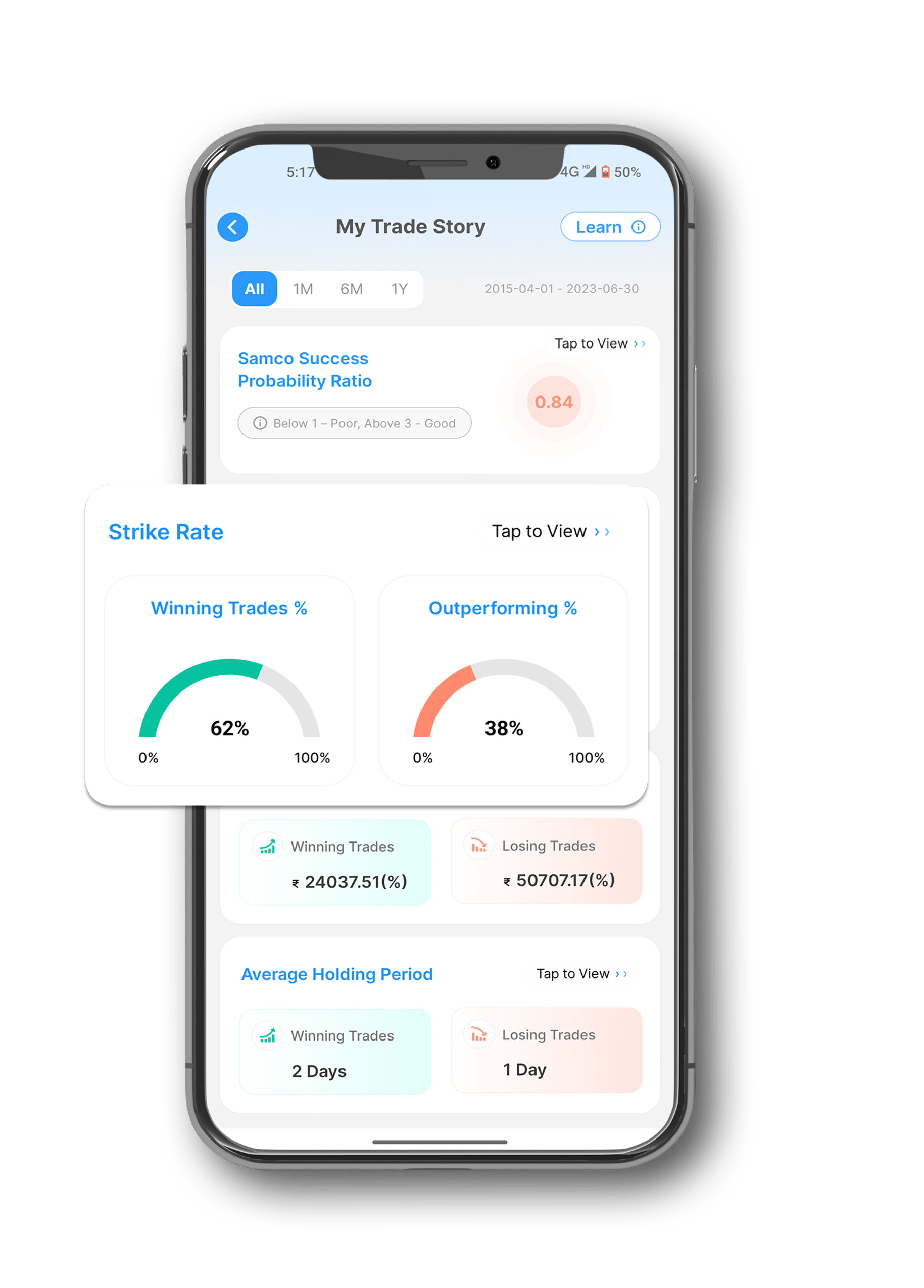
Your current options trading analysis software may have given you a few profitable trades, but how do you assess whether or not you really are a successful options trader? The answer lies in your strike rate, which is a hidden insight offered as a part of the ‘My Trade Story’ feature in the Samco trading app.
In your options trading journey, your strike rate is calculated for both winning and losing trades. Your winning strike rate is the percentage of profitable options trades you execute in a given period. By contrast, your losing strike rate is the percentage of loss-making trades in the same period.
A Practical Example of the Strike Rate
Say you carry out 150 options trades in a month. Of these, 110 are profitable and 40 result in losses. This means your winning strike rate is 73.3% (i.e. 110/150 x 100) and your losing strike rate is 26.7% (i.e. 40/150 x 100). This tells you that as far as the frequency of profitability is concerned, you’ve been fairly successful.
The strike rate can also help you become a better options trader by pinpointing what works and what does not. For instance, say you focus on selling covered calls during a given month. And you find that the strike rate is higher when you sell calls against stocks with moderate but steady growth rather than high-volatility stocks. Using this insight, you can adjust your strategy to choose options with stocks that have stable growth as the underlying assets.
Average Profit and Loss
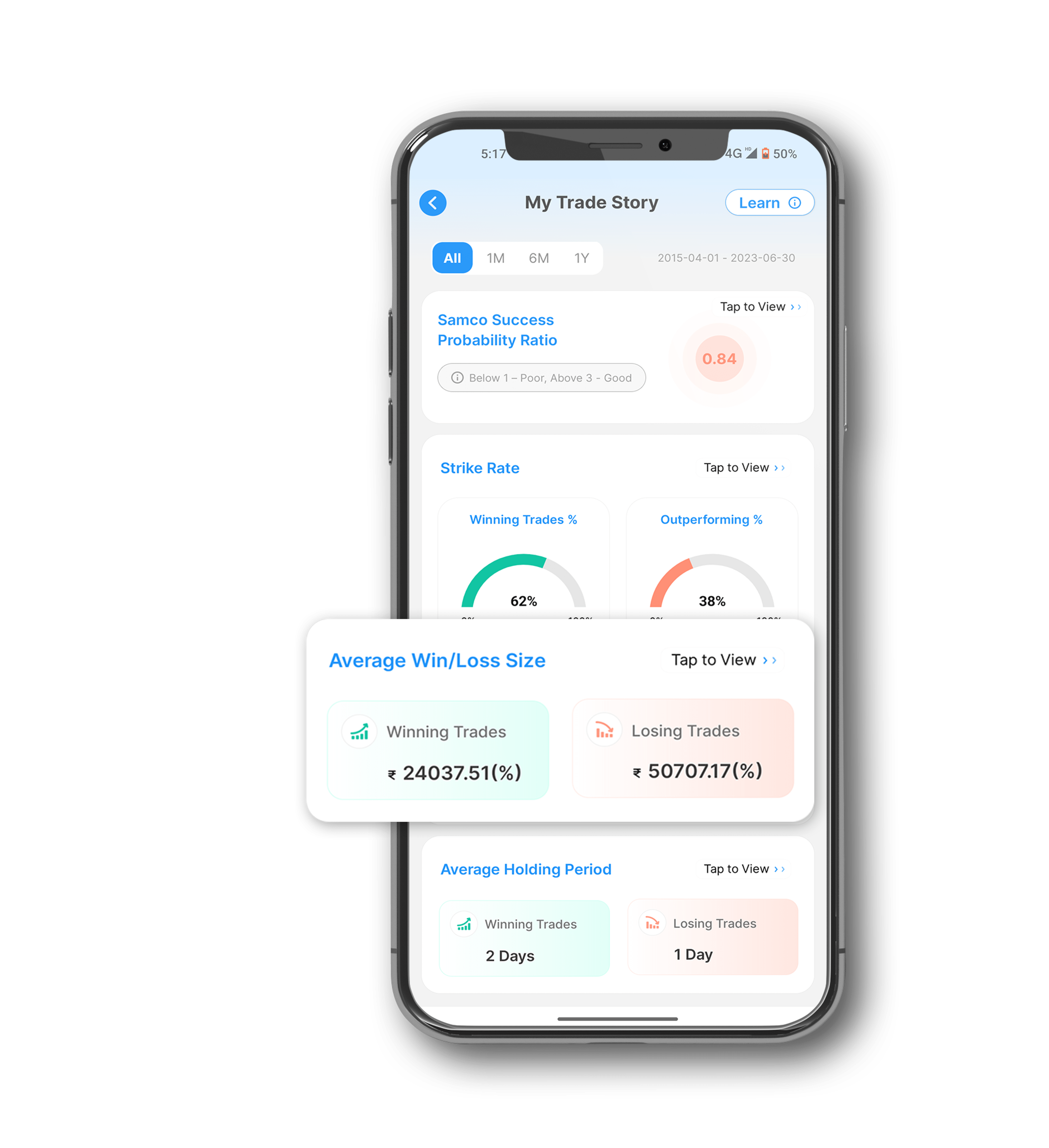
The average profit and loss size tells you the size of the average profit or loss generated per trade during a given period. The Samco trading app gives you the average profit and loss size in both amount and percentage. In other words, while the strike rate gives you clarity about how often you win/lose, the average profit/loss size tells you how much you win/lose.
If your loss size is higher, it indicates that you need to implement a better risk management strategy and limit downside risks. The Samco trading app gives you insights about the average profit/loss size for each options trading strategy as well, so you can assess them and identify which ones are working best for you.
A Practical Example of the Average Profit and Loss
Let’s continue with the previous example. Say the average profit per trade (for the 150 trades executed in the month) comes up to ₹20,000, while the average loss per trade is ₹45,000. This insight, when combined with the strike rate, reflects that while you may have been making profits more frequently, your losses are larger than your gains.
This effectively means that you could end up with a net negative scenario, where your profits are overshadowed by the losses endured. If you find yourself facing a situation where your average loss exceeds your average profit, despite a high winning strike rate, it may indicate the need to revisit your current options trading strategies. You may have to switch to more successful techniques or modify your market outlook.
Average Holding Period
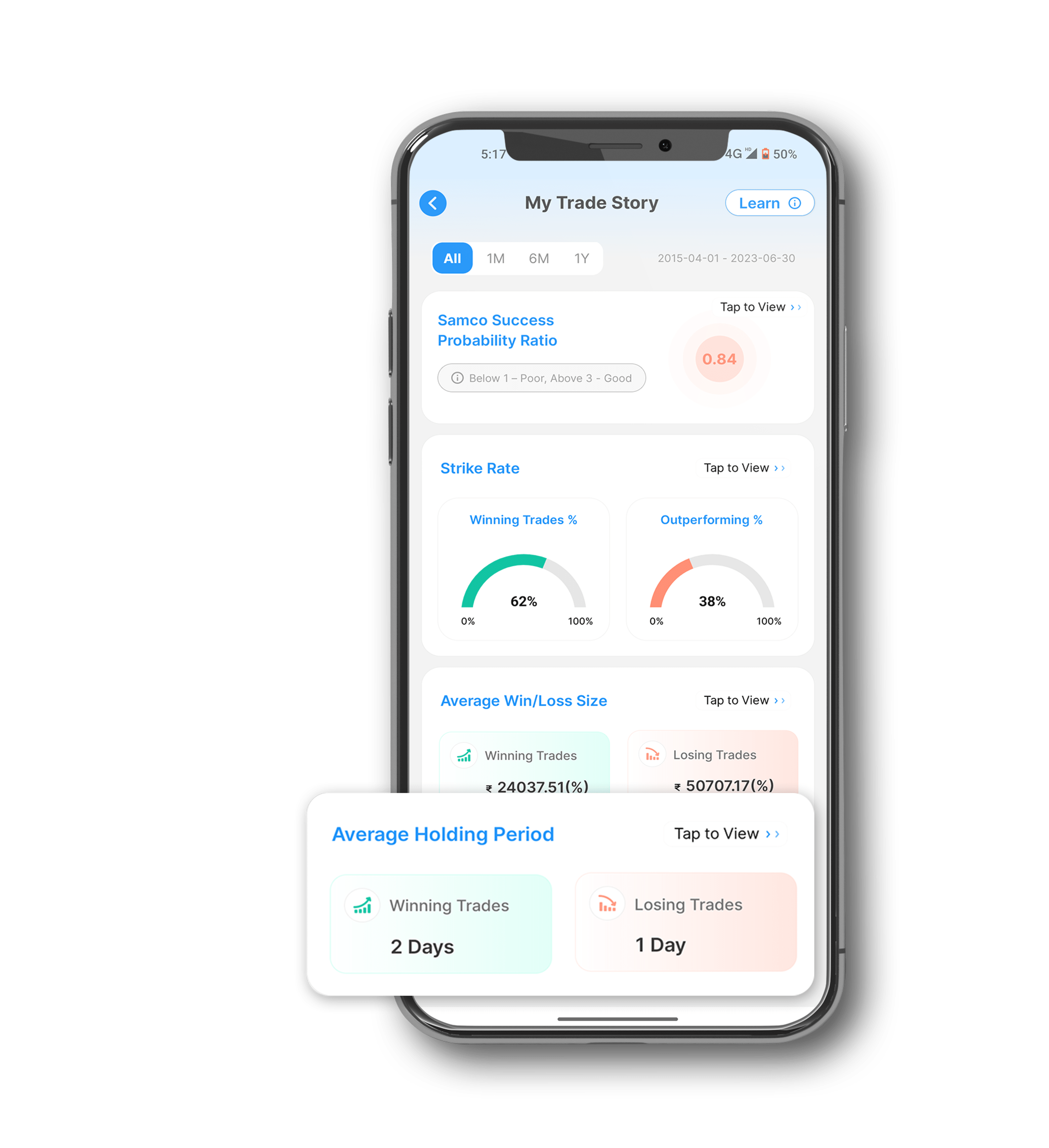
The average holding period is another crucial metric that you’ll find in Samco’s ‘My Trade Story’ feature. It indicates the average number of days over which you held on to profitable and loss-making positions. These periods are quantified as winning and losing days respectively.
Typically, as an options trader, you may tend to hold on to losing positions for longer, hoping that the market may reverse direction and move favourably. In contrast, you may close winning positions earlier than necessary, thus earning less than your maximum profit potential.
A Practical Example of the Average Holding Period
Let's say over the past month, you engaged in multiple options trades. Analysis through Samco's 'My Trade Story' reveals that when you buy a call option in a bullish market, the average holding period is 4 days for profitable trades and 10 days for losing trades. This indicates that you typically choose to sell the option after a modest increase in 4 days.
However, if the stock falls, you tend to hold the option for 10 days, expecting the stock price to rebound. This increases the risk of a larger loss. This tendency to hold losing positions longer can impact your overall trading success. But by factoring in the average holding period, you can let your winners run and cut your losses short.
Samco Trade Score
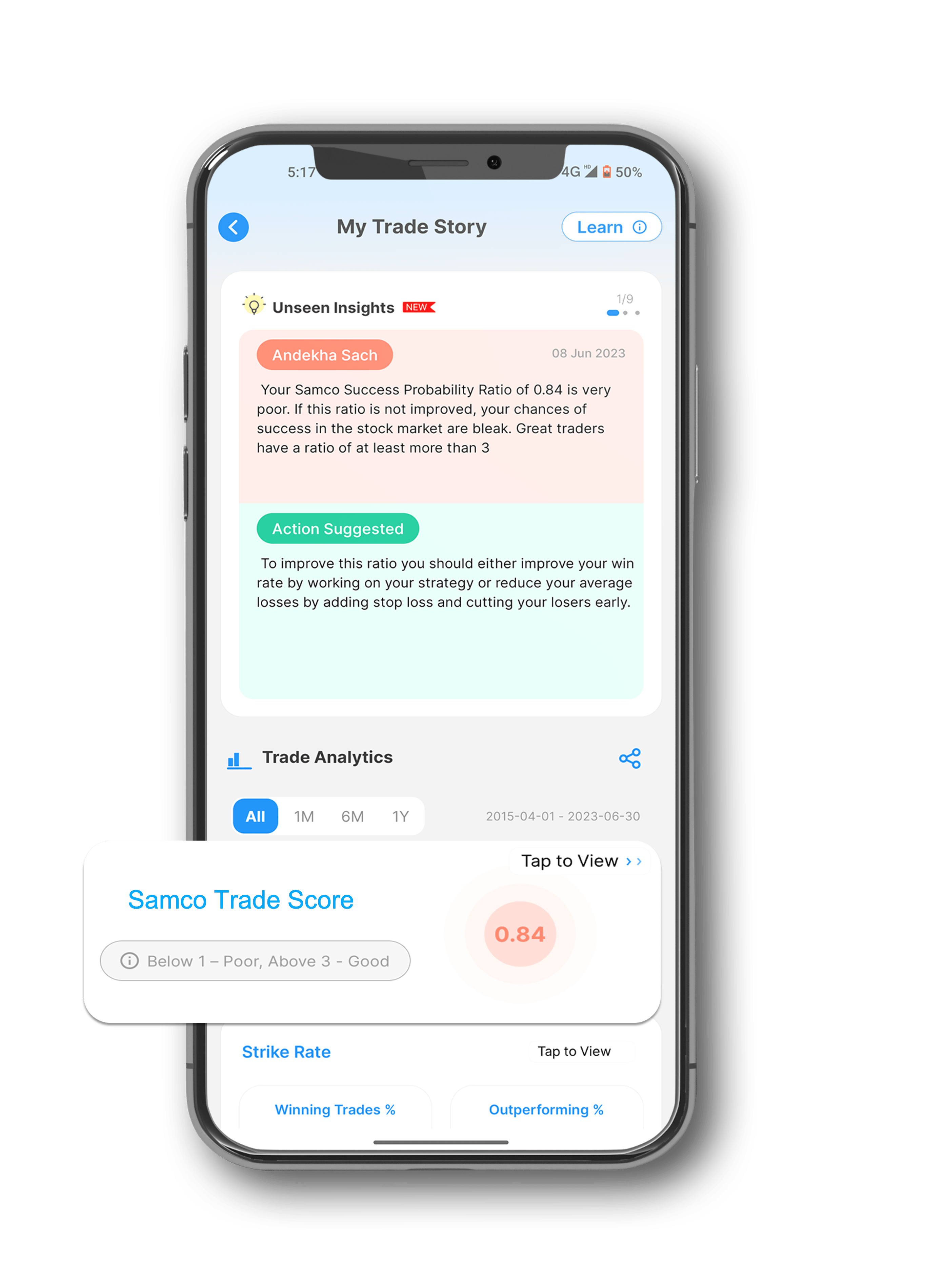
In addition to the finer details of the different aspects of your options trading strategies, you need a metric that can assess your overall success in this market segment. Here’s where the Samco Trade Score can help. This is a proprietary metric that takes into account various aspects like your winning and losing strike rates and your average win and loss sizes.
These factors are used to compute the Samco Trade Score for all your option strategies. Depending on the range it falls in, your score can indicate poor, average or good trading performance as follows:
Samco Trade Score Range | What it Means for the Trader |
Less than 1 | Poor trading performance |
From 1 to 3 | Average to good trading performance |
Above 3 | Very good trading performance |
A Practical Example of the Samco Trade Score
Say your current score is 2.1, indicating that your trades are between average and good. To improve your trade score, you examine your strategies and find that for covered calls, your winning strike rate is high but your average win size is relatively small. Conversely, your straddles show larger average wins but a lower strike rate.
To work around this, you can perfect the entry and exit points for straddles and simultaneously select stocks with more volatile prices to increase the premium income from your covered calls. These adjustments can help you balance the winning strike rate and the profit size, so you can boost your overall Samco Trade Score to more than 3.
Become a More Successful Options Trader with Samco’s New-Gen Trading App
With industry-first insights like the winning and losing strike rate, the average holding period, average profit and loss sizes and our proprietary Samco Trade Score, you can revolutionise the way you trade in the futures and options market. All you need to do is download the Samco trading app and become a member of the Samco trading community.
That said, if you already have a trading account and use a different options trading analysis software, you may be unsure about how to switch to Samco. The good news is that switching to Samco is extremely easy, and you can complete the process online within minutes. Once that’s done, you can access all the hidden insights and analytical tools required to elevate your options trading, improve profitability and become a better and more successful F&O trader overall.
Disclaimer: INVESTMENT IN SECURITIES MARKET ARE SUBJECT TO MARKET RISKS, READ ALL THE RELATED DOCUMENTS CAREFULLY BEFORE INVESTING. The asset classes and securities quoted in the film are exemplary and are not recommendatory. SAMCO Securities Limited (Formerly known as Samruddhi Stock Brokers Limited): BSE: 935 | NSE: 12135 | MSEI- 31600 | SEBI Reg. No.: INZ000002535 | AMFI Reg. No. 120121 | Depository Participant: CDSL: IN-DP-CDSL-443-2008 CIN No.: U67120MH2004PLC146183 | SAMCO Commodities Limited (Formerly known as Samruddhi Tradecom India Limited) | MCX- 55190 | SEBI Reg. No.: INZ000013932 Registered Address: Samco Securities Limited, 1004 - A, 10th Floor, Naman Midtown - A Wing, Senapati Bapat Marg, Prabhadevi, Mumbai - 400 013, Maharashtra, India. For any complaints Email - grievances@samco.in Research Analysts -SEBI Reg.No.-INHO0O0005847



 Easy & quick
Easy & quick
Leave A Comment?